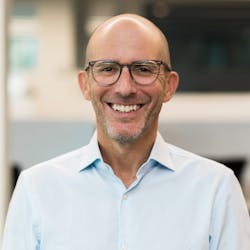When the final numbers were tallied, only 44 oncology practices signed up to participate in the Enhancing Oncology Model, the Center for Medicare & Medicaid Innovation’s follow-up to its earlier value-based care model in this space, the Oncology Care Model. While those numbers might be disappointing, Bobby Green, M.D., president and chief medical officer at oncology-focused value-based care platform company Thyme Care, recently told Healthcare Innovation that the practices getting experience in value-based care now will benefit down the road.
Prior to joining Thyme Care, Green was chief medical officer at Flatiron Health, which has built up an oncology-focused EHR network and a de-identified database from more than 280 U.S. academic and community cancer clinics in order to enable large-scale real-world research. Before that, he was managing partner at Palm Beach Cancer Institute, where he helped lead its merger with Florida Cancer Specialists in 2013.
HCI: I am hoping you can share your thoughts about the Enhancing Oncology Model, but first could you talk about the origins of Thyme Care and its business model?
Green: I was at Flatiron for seven years. It is solving the problem of all this data getting generated at the point of care and not be used for anything. That was certainly a problem that I saw over and over again as a practicing clinician and one of the appeals of Flatiron was an opportunity to use technology in the startup environment to solve some of those problems.
My co-founder Robin Shah, who I met at Flatiron, and I both recognized that you could do the best job in the world of taking care of people when they were sitting in front of you, but they'd walk outside the office and bad stuff would happen. If you think about all the things that don't work well outside the office, — people getting confused about their medications, people getting confused about their prognosis, people not being able to get rides to the office, people getting evicted from the homes— there are so many barriers to care. In the oncology literature there have been a fair number of studies that show that there are interventions that you can make that broadly fall under the term navigation that work to improve outcomes, to reduce cost of care, and in some cases, to improve overall survival.
We have taken an approach similar to Flatiron’s in a way. Flatiron perfected technology-enabled abstraction, which is not a novel concept, but that was complex, hard to scale, overly expensive, and hard to maintain quality. They built a really good model around that. So similarly, we built a technology-enabled navigation platform, for both clinicians and non-clinicians to do the virtual navigation on a software and analytics platform. We partner with health plans, which see the value in this and are willing to pay for it. We will take some degree of risk on the cost of care of the populations that we're managing. And when we partner with a health plan and go into a geographic area, we also partner with oncology practices that are in line with the vision of doing this.
We started off in New Jersey with two health plans and are now also live in Georgia. One other risk-bearing entity that we haven't announced publicly yet and one other national health plan are both signed and will be going live later this year. Also, we thought our platform was a relatively good fit for practices doing the Enhancing Oncology Model, and we have a partnership with a large oncology group to help them execute on the EOM that we will announce soon.
HCI: Can you talk about why value-based care is particularly challenging in the oncology space?
Green: In general, part of it is optics. The thing that is different about cancer than most other specialties is the drug spend. There is a perspective in cancer to look at the drug spend as being so large that nothing else matters, and there's nothing we can do about it. Our perspective is that, yes, drugs are a big part of the spend. But there are a lot of unnecessary admissions, a lot of unnecessary time in the hospital. There's still care at the end of life that is unnecessary for a variety of reasons where we can move the needle. I think the Oncology Care Model bore this out.
I look at the world of approaches to cancer drugs spending in two buckets. There's ubiquitous utilization management — prior authorization. But we live in a fee-for-service world, and I think what OCM showed us is that if you incentivize people to spend the time and give them the tools to do everything they can to actually reduce the cost of drug spending, there are things that you can do beyond utilization management.
The other reason it's hard is that cancer is really so many different diseases. There's obviously breast cancer, colon cancer, lung cancer, but even within a disease like breast cancer or lung cancer, is it early stage or advanced? That has huge implications, not just in terms of how you treat the patient and prognosis, but also on what the expected spend is. I think from an analytic perspective, from an actuarial perspective, understanding cost drivers and moving the needles in cancer is particularly difficult.
HCI: I see announcements from the Community Oncology Alliance railing against the pharmacy benefit managers. Is that what you're describing with the utilization management?
Green: I would say it goes beyond COA. I think is widely seen in the clinical community in general and it also goes beyond oncology. I mean, if you just sort of look at Med Twitter and all the talk about prior authorization. It is the combination of the administrative burden of this, which drives up costs and creates problems — whether it's academic hospitals or small independent community practices. It is also the feeling that it's not just about controlling some particular high-cost drugs, but that they are just going to put barriers up and hope that it reduces the cost of care.
HCI: CMMI describes EOM as being built on lessons learned with OCM. What are some of the lessons learned in OCM that shaped EOM?
Green: I'll just highlight a few. One is that number of diseases has shrunk significantly. CMS took out the lower risk breast cancer and lower risk prostate cancer patients, which actually made up a large number of the patients that were in OCM. CMMI’s goal is to save money. In this population, most of the interventions around acute care utilization, keeping people out of the hospital, end-of-life care are going to be less likely to impact the relatively healthier, lower risk group of people.
Another change involves a novel therapy adjuster, which is basically attempting to not penalize practices for rapidly uptaking new therapies. It was previously adjusted at the practice level; it's now adjusted at the disease level, which again goes to my point before about cancer being multiple diseases. When you apply something as a blanket for cancer to a practice, you can be really adversely impacted if you're a practice that sees a disproportionately high percentage of cancer type A versus cancer type B. So they are really trying to level the playing field there.
I think another learning that they had, which the oncology practices didn't love, was lowering the MEOS [Monthly Enhanced Oncology Services] payments. I think a couple of the other really big things in the program are the mandatory risk. There was an option to take downside risk in OCM, but the risk is mandatory in EOM, which I think is one of the things that, quite honestly, scared a lot of practices from going into this. Which is totally understandable. Most clinical practices are not geared or set up for understanding this. The other two things are the added features, specifically around health-related social needs screening and electronic patient reported outcomes, which are, from a care delivery perspective, really important, but they also create an operational burden for practices.
HCI: The final number of practices participating in EOM is 44. Do you think that's lower than what CMMI’s expectations probably were?
Green: Almost certainly that number is lower than they would have liked. It is definitely lower than the OCM was, but at the same time, there are some very large, high-profile groups that are in it. They're obviously people who see this as an opportunity to be successful in it to show their value-based chops and to get their sea legs.
HCI: I know you haven’t announced yet the practice you are working with on EOM, but what kinds of services will Thyme Care be providing to them involving the model?
Green: I would put it into a couple of different buckets. One is just the core navigation that is required in EOM — the nurses and the lay health workers who are interacting with patients, that component of it along with the added things like health-related social needs screening, are things that we were already doing in the context of our health plan relationships. EOM is different, but the model was very applicable to that. Bucket two is the analytic and actuarial support to analyze data on a go-forward basis and use that data to make sure that you're doing the things over time that are going to make you successful. The last component of it was we are taking some of the downside risk off the plates of the practices as part of that contractual arrangement.
HCI: Anything else you want to stress?
Green: Although the numbers are lower in EOM than OCM, CMS is the biggest payer and anytime CMS does a program like this, it gets people's attention. I think OCM changed the conversation around value-based care in a lot of ways and I think EOM will continue to do that. We've been saying this for a long time, but I also believe it's true that we are moving toward value-based care. I think that it is going to happen in oncology, and like anything else in life, the more you do something, the better you can be at it. For the practices participating here, it's going to be a real opportunity to learn and get better at delivering value.


